This year, I decided to document my garden through the seasons. One of the incredible things about gardening in Alaska is how your garden transforms overnight. It’s magical, amazing, and perhaps why I love gardening. Only this summer Things. Did. Not. Grow. Until July. But then there were some pleasant surprises.

Here is how my garden grew this summer. . .
May
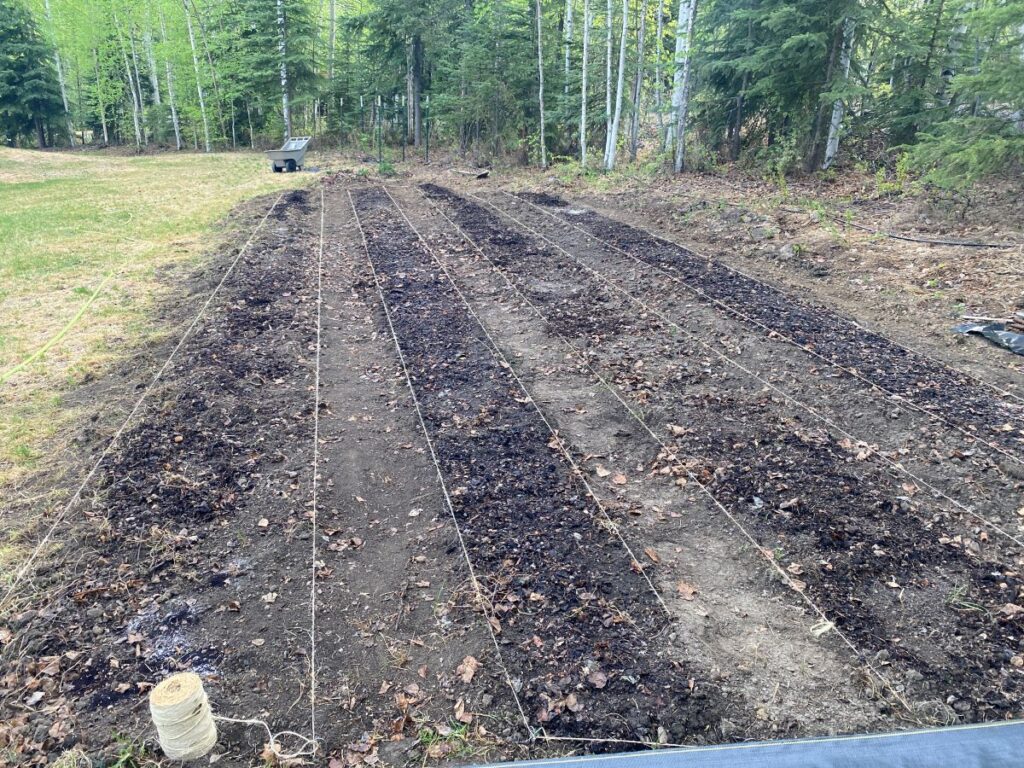
I tilled the garden beds in the fall, so that helped me get an early start (otherwise, I would have had to wait until the soil dried out enough to till before I planted). I raked and fertilized and lined out the beds on May 19, which saw a high of 80 degrees Fahrenheit. Then I direct-seeded much of the garden on May 20 (a high of 75 degrees).
I don’t start many seeds indoors but for people who do, this spring was hard because transplants were ready to go outside before the weather was warm enough. If you start seeds too soon indoors, they get leggy and unhealthy before you can put them outdoors. If you start them too late, then your garden is delayed.
This calculator helps me figure out when to start seeds indoors.
I always risk planting seeds outdoors on the early side because I buy large packets of seeds online. Seeds are cheap (I buy online in bulk) relative to the time and space investment of starting your own or buying from a greenhouse. This spring, however, I did feel like I was investing a lot of time and energy in keeping the seeds moist outside in the May wind and heat.
One trick that I did not do this year that I should have done is to cover my seeds with frost cloth. It helps hold in moisture during this critical time and warms the soil, which can be helpful too.
After planting, I installed weed fabric around my garden and drip irrigation. I still had to hand water until my plants were established, as drip irrigation is more effective when plants have healthy root systems.
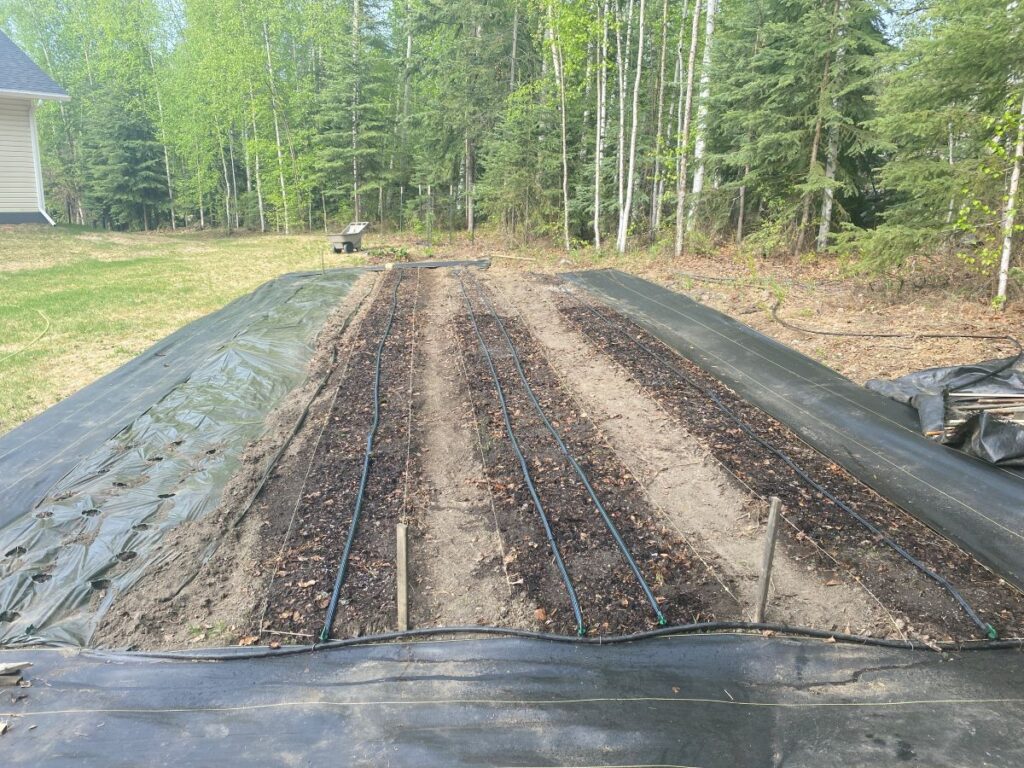
I wrote down my planting dates, what I planted, and notes on varieties for most of the things I planted as I knew I would forget. I’m not as good about making records when I plant later in the season.
Garden Journal
Planted May 20: beets (Zeppo); carrots (Napoli, Scarlet Nantes); snap beans (Antiqua, Provider); spinach (Space, Kookaburra); lettuce (Allstar Gourmet Lettuce Mix); peas (Sugar Ann); flowers (zinnia, Scabiosa, firecracker dwarf sunflower, black-eyed Susan, amaranthus, Love-Lies-Bleeding).
June
June 1 has been the “safe day” to plant for as long as I can remember. But this year, instead of continuing to warm, temperatures took a dramatic drop and the low was 33 degrees on June 1. The average temperature was 15 degrees below normal. June 2, the low was 39 degrees.
Of course, climate change brings more unpredictability. It’s always interesting and helpful to view past, current, and projected growing season lengths across Alaska with the Alaska Garden Helper, but more than ever, the weather is unpredictable.
After hardening off plants, bringing them in and out and putting them into larger pots, I had some plants outside that I didn’t feel like heaving in once again that were negatively affected by the cold. I’m not sure how it affected my yet-to-emerge seeds. Perhaps the cold delayed their germination or killed some.
I grew Marketmore and Diva cucumbers in the ground in infra-red transmitting (IRT) plastic along with basil, under a low tunnel that I removed as the cucumbers outgrew them. I grew the English cucumber in a large, black container.
I think June is why I love gardening in Alaska. Seemingly overnight, the garden doubles in size in the Land of the Midnight Sun. But that didn’t happen this year. I watered and watered because of the heat and the wind and it just sat there.
On June 25th, things were still small and unimpressive after watering daily or twice daily for almost a month. In spite of gardening here for decades, and building a career around gardening in Alaska, I doubted my abilities as a gardener. I kept buying more plants and planting more seeds just so something would happen. I realized this is a habit I have to watch out for.
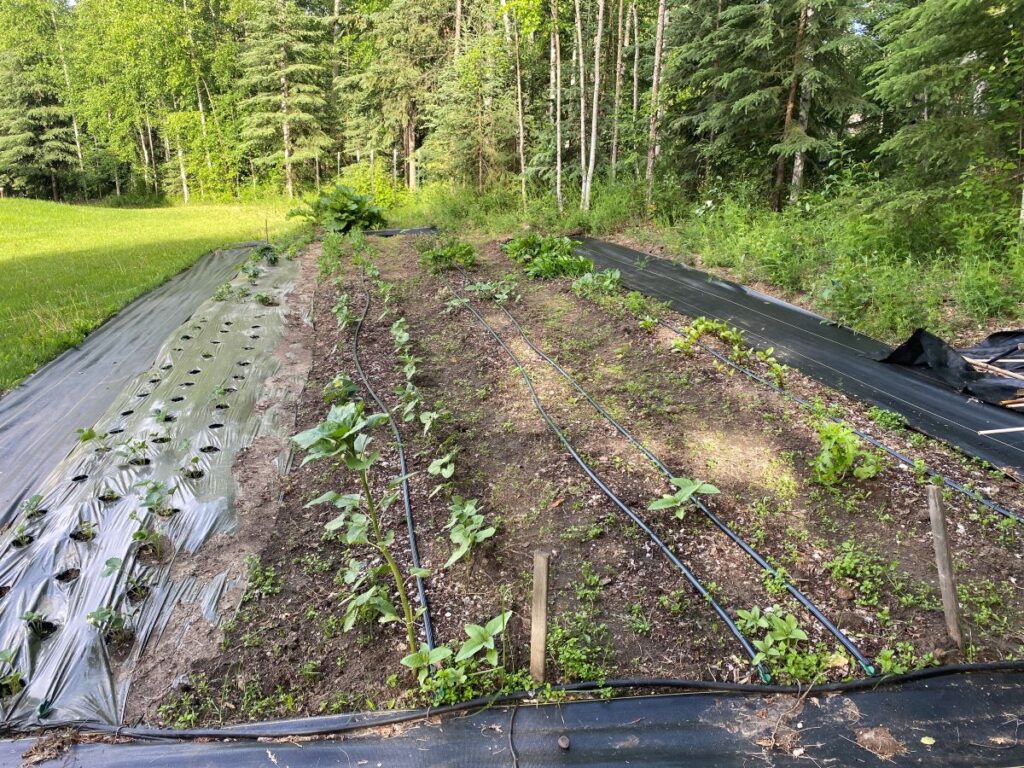
When I plant carrots at the proper spacing, for instance, I really have to try hard not to go back and plant more as I worry about blank spaces in my garden. It is hard for me to refrain from planting more at this stage in the growing season. However, the conditions were awesome for spinach (Space, and Kookaburra) and butterhead lettuce (Adriana). The rhubarb and chives also were plentiful.
The big tasks for June were weeding, watering, and planting to fill in holes either where things didn’t come up or they were slow to come up.
Finally, at the end of June, things started growing. I was determined to grow a lot of strawberries this year, so I added a low tunnel over them to spur them along. They still weren’t nearly as prolific as I had hoped.
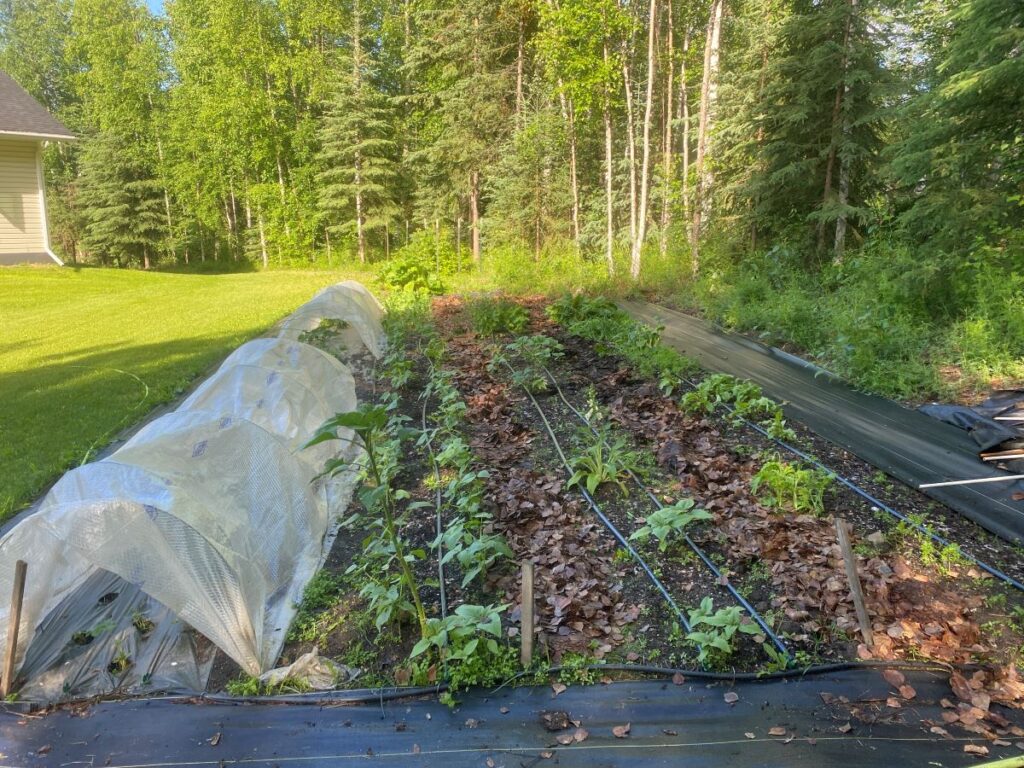
July
July brought some pleasant surprises. The snap beans (Antiqua and Provider) and cucumbers (Diva, Marketmore, and English) were prolific.
I did have a little visit from moose. Not having a fence is a big risk I take for a couple of reasons. I like the aesthetics of it. I like the ease of being able to access the garden from all sides. Building a fence is expensive, and controlling the weeds around it can be difficult. I also like the idea of being able to easily expand or change the shape of my garden. In any case, the moose did not devastate the garden, and I think they would have if I had planted broccoli, cabbage, or anything else in the Brassicaceae family. As it was, they gave the Swiss chard, the beets, the lettuce, and the strawberries a trim, but really did little damage overall.
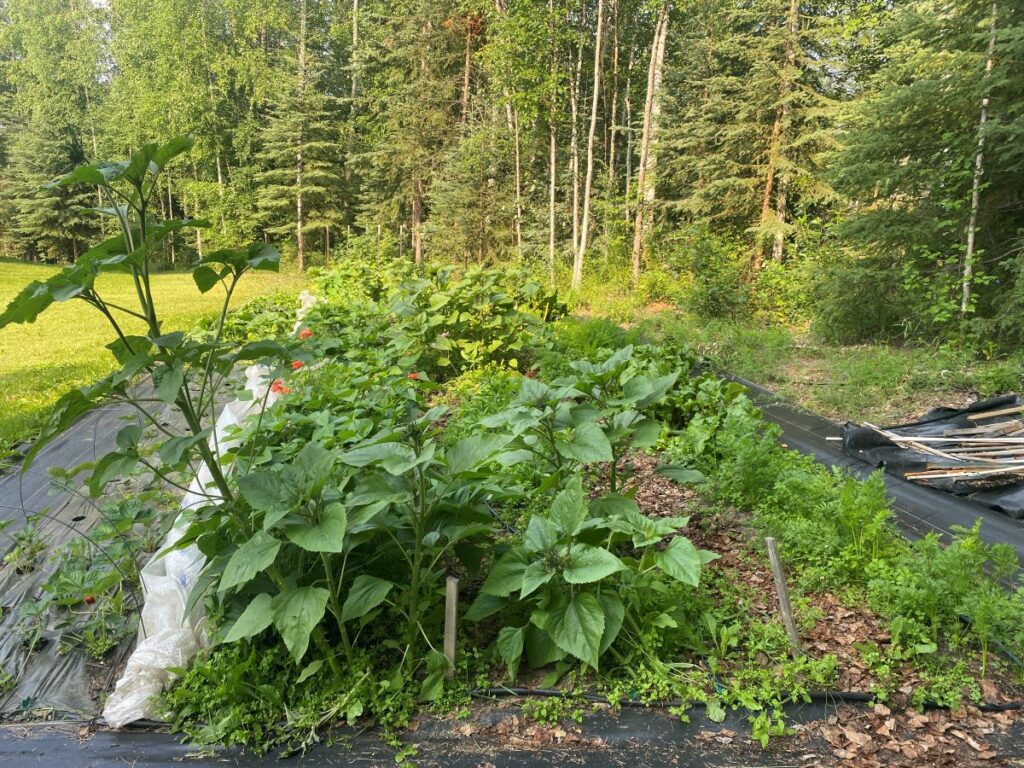
The main tasks of July were weeding, harvesting, and more watering. But instead of needing to water by hand with the hose, my drip irrigation system worked well for the established plants.
August
This is the time of year I can go two or three weeks without going to the grocery store. That alone is reason enough to grow a garden. The main task for August is eating veggies and making bouquets.

This is the time to preserve your veggies if you have a bumper crop and if you have the time. My 2-year-old managed to remove every snap bean from every meal but loved the baby cucumbers. My older kids ate a cucumber most days, and harvested carrots, peas, beans and lettuce. They also snarfed up the few strawberries that were available and they all enjoyed the raspberries.
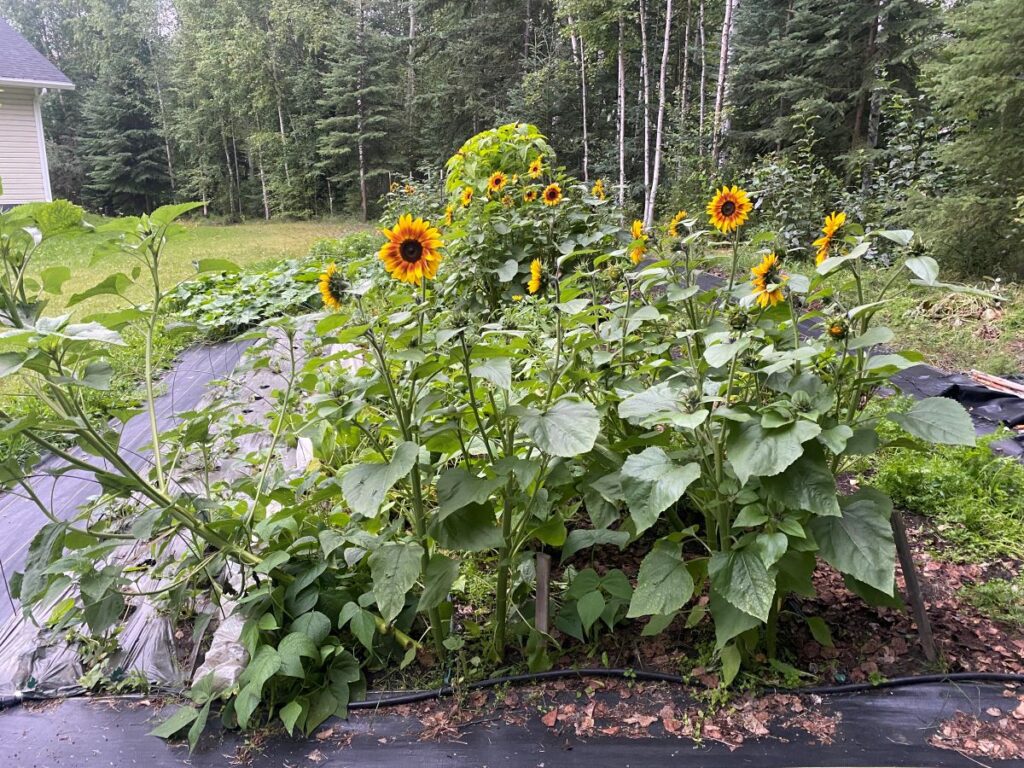
September
With the rain and cooler weather, the main task, if you can call it that, is eating from the garden. One recent dinner was an eclectic all-veggie dinner: fresh cucumbers and carrots, sautéed beet greens and Swiss chard with burrata cheese, sautéed zucchini and rosemary, slow-roasted tomatoes, and puffball mushrooms. I cooked these all separately, although they could have been combined, as well.

My gardening focus is growing enough to eat fresh. I don’t feel like I have much time to dedicate to canning and freezing my garden produce, but I did make some refrigerator pickles. The University of Alaska Fairbanks Cooperative Extension Service has loads of recipes and directions for preserving your garden produce.
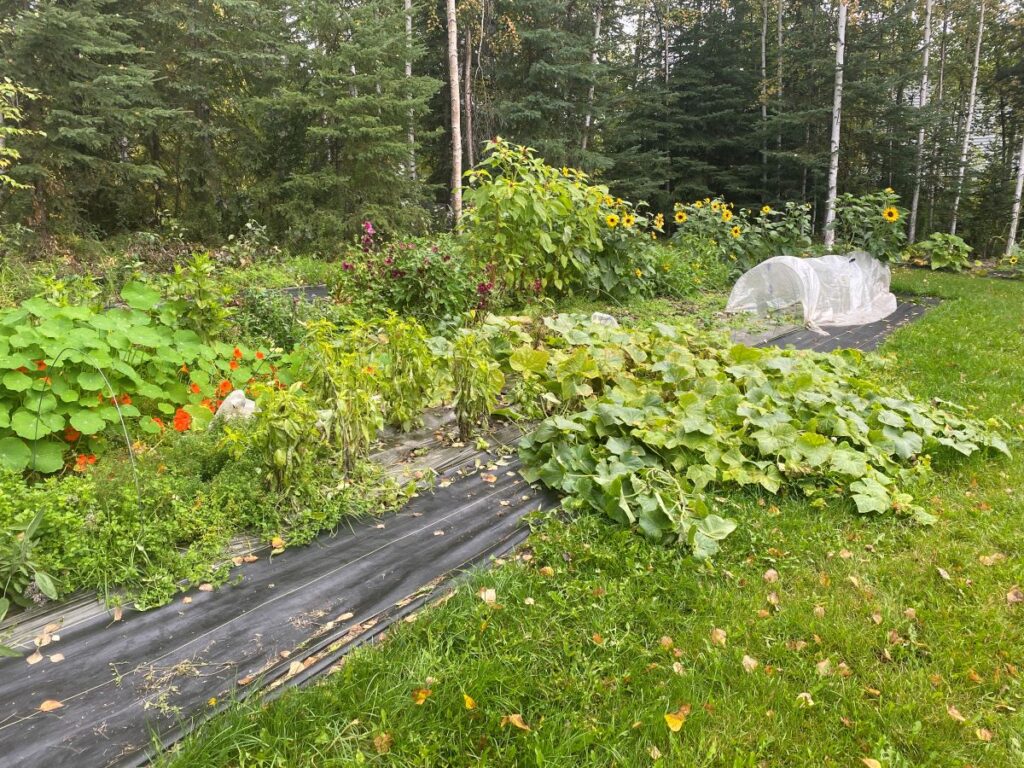
The Alaska Garden Helper predicted that for 2020-2029, the average first frost in the fall would be September 23rd. There were some light frosts before, but the first hard killing frost was September 24th.
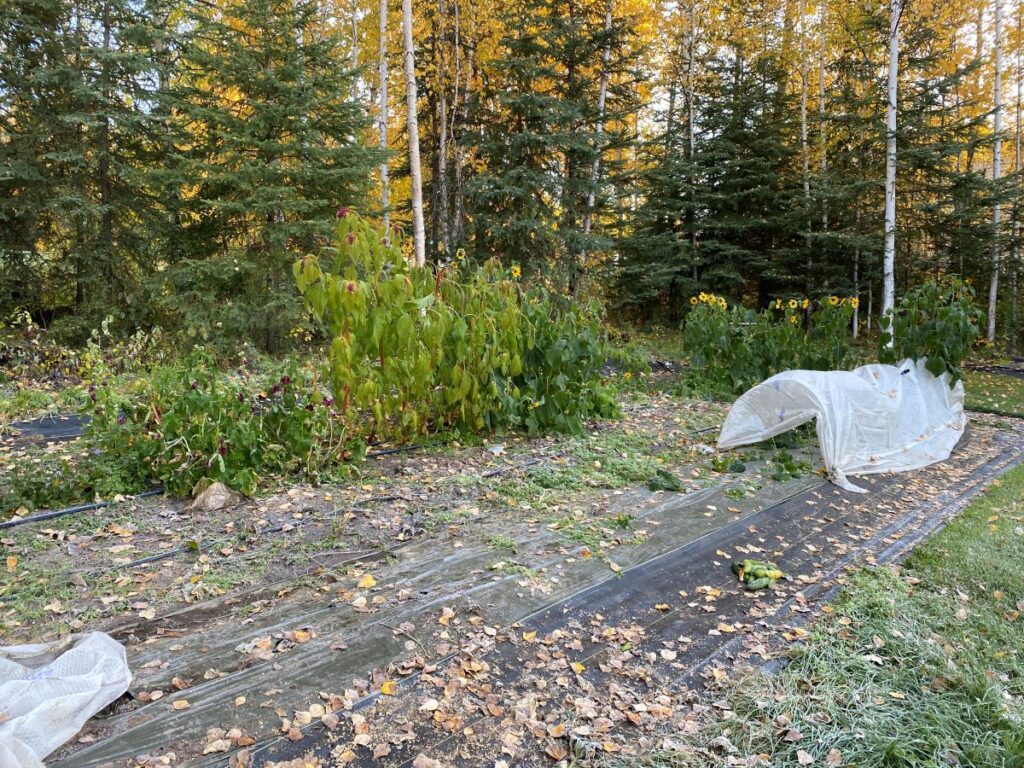
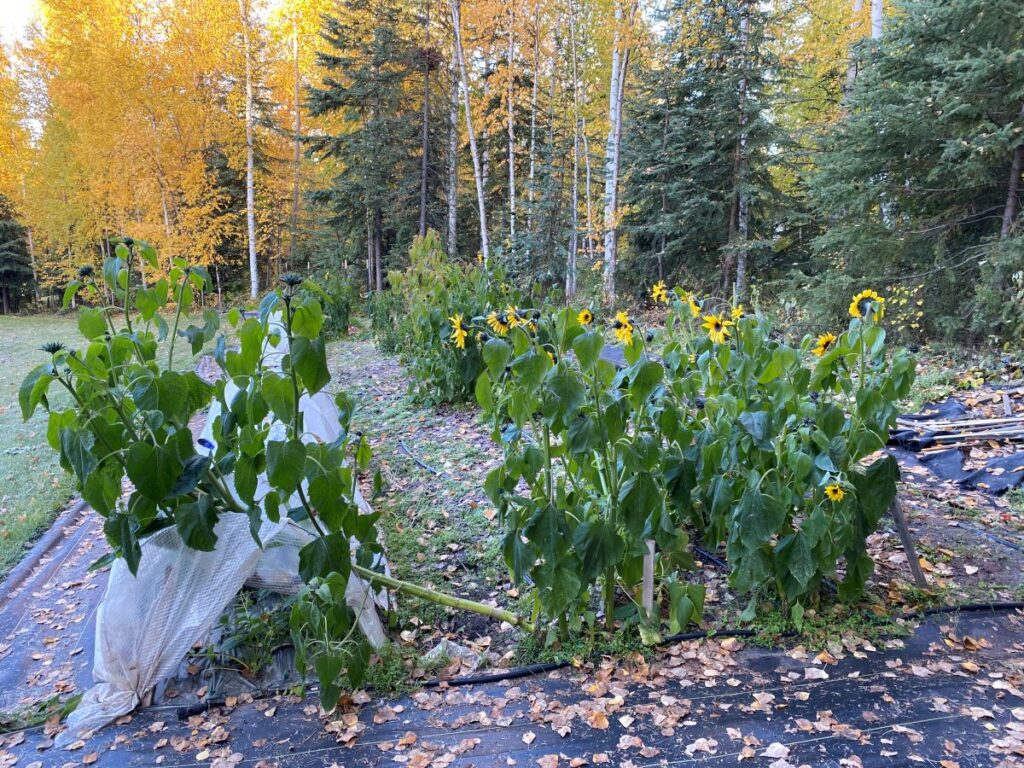
After the killing frost, it is time to put the garden to bed for the winter.
The Season in Review
The end of the summer is another time I try to take notes. What grew well, what I had too much of or too little of and what I want to plant next year. Growing a variety of things, including some things as an experiment, seems to work well. I always grow spinach because I love fresh spinach, especially the large-leaved varieties. Growing spinach usually is an utter failure because it bolts so quickly, yet this year the leaves were luscious and plentiful.
The cucumbers were filler for a little extra space I had. I expected that if I was lucky, I might get a few cucumbers. But I was harvesting 10-15 cucumbers every few days. That was a pleasant surprise. The cucumbers vastly outgrew the space in the low tunnel. Luckily, they had the lawn to spread onto.
I was disappointed in the strawberries and the ranunculus, but I’ll probably keep trying. I had saved the corms from my ranunculus last year and tried to give them a boost by starting them indoors. It seemed like they did better last year directly planted in the garden. I’ll keep trying to grow more strawberries, maybe starting them earlier or trying a different variety. The Albion variety that Andy Harper grows is incredible!
The rhubarb was productive and held up from May until September. I love to grow vegetables that I can harvest throughout the summer and not just at the end.
Usually, I’ve mostly grown things I can eat. But over the years, and probably influenced by my flower farmer sister, I’ve grown to love having fresh cut flowers all summer inside the house, and in the garden as well.
Gretchen Kerndt at the Tanana Valley Farmers Market allowed me to mix and match flower transplants. I appreciated having the extra variety. I also direct-seeded many flowers. Some of them were quite slow to grow and I think I’ll start them indoors next spring. With the cost of transplants, I’m going to try a seed-starting method one of my Master Gardener students talked about in this blog, using the AeroGarden.
What grew well early in the season? Spinach. It was incredible, probably the best I’ve ever grown in Fairbanks, Alaska. Then the cucumbers and beans and sunflowers, holy cow!
Luckily I recorded some of the varieties. Adriana buttercrunch lettuce and Space and Kookaburra spinach were incredible. The Marketmore and Diva cucumbers in the ground in the IRT plastic did amazing, as did basil. The Antiqua and Provider beans did amazing. The Antiqua beans were much more tender than the Provider beans.
What didn’t grow so well? Strawberries, and ranunculus, sadly.
One of the big take-home messages of this summer was to grow a variety of things. In particular, grow plants that do well in cool, rainy weather as well as plants that do well in the heat. The spinach and lettuce thrived early on, while the cucumbers, snap beans, and basil took off with the heat.
I’m already thinking about my garden for next year. Is it too early to order seeds?
Previously published in the Fairbanks Daily Newsminer September 17, 2023